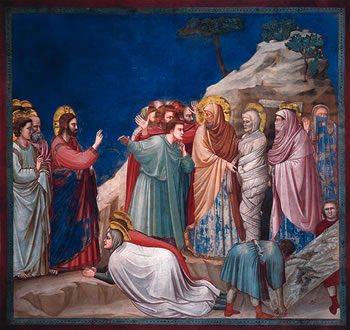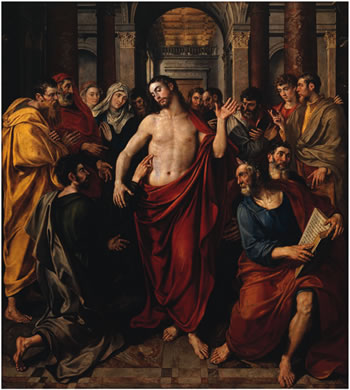Come and See — Really See — Jesus, and Have Life (2)

Fr Tony King SM
A recurring invitation in St John’s Gospel:
We encounter Jesus again in Chapter 11 as the source of life, and His seeking to be believed in, to be really seen as such.
Jesus’ friend Lazarus had died before He and His disciples had reached Bethany, where Lazarus and his sisters Martha and Mary lived. On their arrival, Martha said to Jesus that if He had been there, her brother would not have died. Then Jesus said:
I am the Resurrection.
Anyone who believes in Me, even though that person dies, will live.
And whoever lives and believes in Me will never die.
Do you believe this?

Raising of Lazarus, Giotto, 1574
Martha’s reply expresses faith, a ‘seeing’ of Jesus with mind and heart, beautifully yet inadequately:
Yes, Lord, I believe that you are the Christ the one who was to come into the world.
Yet, not a full seeing – of Jesus as the source of life, the giver of life; so that physical death doesn’t close off life for the believer. Hence, when they come to the tomb and Jesus orders the stone to be removed, she protests.
Lord, this is the fourth day!
And Jesus replies:
Have I not told you that if you believe you will see the glory of God.
So, they take the stone away and Jesus calls Lazarus forth, to life again. Martha, Mary and the people see the glory of God, of course, in the miracle worked. However, Jesus’ assurance is also one of seeing God Himself in His glory in everlasting life, for the believer who really ‘sees’ Jesus.
The last ‘come and see’, so to speak, before His passion, death and Resurrection, occurs in chapter 12. It is near Passover time, and Jesus has ridden into Jerusalem and been hailed as King. Among the crowds present for the great festival are some non-Jews, gentiles. These Greeks approached Philip, one of the disciples, with a request.
Sir, we should like to see Jesus.
Philip told Andrew and they together told Jesus. Jesus’ response at first seems strange; He speaks of the grain of wheat that must fall and die for it to bear fruit.
Jesus likens Himself to a grain of wheat; He is to die, so as to be the channel of everlasting life to all. He goes on to say:
Father glorify your Name . . .
When I am lifted up from the earth I shall draw all people to myself.
The evangelist remarks that by these words, He indicated the kind of death He would die.

The Incredulity of Thomas, Maerten de Vos, 1574, Royal Museum of Fine Arts Antwerp
Jesus being ‘lifted up’ is not only to death on the cross, but also to glory in His Resurrection. The Greeks had asked to see Jesus. But He, now that His ‘hour’ had come, expresses once again what real seeing Him is – faith in Him, the crucified and risen One, who is God’s source of real life to us. That is the ‘seeing’ through which we are gifted with eternal life.
After Jesus completes His Passover and is lifted up to new life and glory, the disciples refuse to believe the women who first encountered Him. And Thomas the apostle continued to voice his doubt even after Jesus appeared to the others; until Jesus came again. Then he moved to profound faith.
He saw the risen Jesus, bodily, with the marks of His wounds, but he also ‘saw’ way beyond that; he ‘saw’ all that it was possible for him to see.
Jesus had said to the two disciples of the Baptist ‘come and see.’ Now He has come to Thomas, and Thomas has at last seen.
Jesus’ final words to the Apostle are such a source of strengthening to our faith and hold the only beatitude in St John’s Gospel: You believe because you can see me. Blessed are those who have not seen and yet believe
(John 20:28, 29).
Most of the first Christians, becoming believers through the preaching of the Apostles had never seen Jesus. They and we together are among those blessed by God indeed, for though we haven’t seen Jesus bodily, we ‘see’ Him really by the faith vision that we have in the Living One:
I am the Living One. I was dead and look – I am alive for ever and ever (Rev.1:18).
Let us constantly give the Lord thanks for this great gift. Let us seek from Him the deepening and strengthening of our faith, so that we ‘see’ Jesus ever more clearly and respond to Him in grateful love.
 Entries(RSS)
Entries(RSS)